2005 FORD TAURUS radio
[x] Cancel search: radioPage 15 of 248

AM/FM STEREO (IF EQUIPPED)
1.Clock:
To set the hour, press and
hold the H control. When the desired
hour appears, release the control.
To set the minute, press and hold
the M control. When the desired
minute appears, release the control.
2.Bass:Press
/to
decrease/increase the bass output.
3.Treble:Press
/to
decrease/increase the treble output.
4.Balance:Press
/to shift
sound to the left/right speakers.
5.Fade:Press
/to shift
sound to the rear/front speakers.
6.Scan:Press SCAN to hear a brief
sampling of all listenable radio
stations. Press again to stop.
7.Memory preset buttons:To set
a station: Select frequency band
AM/FM1/FM2; tune to a station,
press and hold a preset button until sound returns.
BASS
TREB
BAL
FADE
Entertainment Systems
Entertainment Systems
15
Page 17 of 248

To set the minute, press and hold
the M control. When the desired
minute appears, release the control.
3.CD:Press to play the CD (if
equipped).
Note:This system is CDDJ
compatible, but CDDJ is an option with limited availability as defined in
the order guide.
4.Bass:Press
/to
decrease/increase the bass output.
5.Treble:Press
/to
decrease/increase the treble output.
6.Balance:Press
/to shift
sound to the left/right speakers.
7.Fade:Press
/to shift
sound to the rear/front speakers.
8.Scan:Press SCAN to hear a brief
sampling of all listenable radio
stations, tape or CD selections.
Press again to stop.
9.Shuffle:Press to play CD tracks
in random order.
10.COMP (compression):While
playing a CD, press to bring soft and
loud passages together for a more
consistent listening level.
11.
Dolbytnoise reduction:
Reduces tape noise and hiss while
playing a tape, press to
activate/deactivate.
BASS
TREB
BAL
FADE
Entertainment Systems
17
Page 18 of 248

12.Side 1±2:Press to change tape
direction.
13.FF (fast forward):Press to
advance the tape or CD.
14.REW (rewind):Press to rewind
the tape or reverse the CD.
15.Memory preset buttons:To
set a station: Select frequency band
AM/FM1/FM2; tune to a station,
press and hold a preset button until sound returns.
16.Tune:Works in radio mode or
CD mode. Press
/to change
frequency down/up or previous/next
disc.
17.Cassette door:Insert a
cassette into the cassette door.
18.Seek:Press and
release
/for previous/next
listenable radio station, tape
selection or CD track.
19.Power/volume:Press to turn
ON/OFF; turn to increase or
decrease volume levels.
20.AM/FM:Press to choose a
frequency band in radio mode
(AM/FM1/FM2).
21.EJ (Eject):Press to eject a
tape.
VOL
PUSH ON
AM
FM
Entertainment Systems
18
Page 20 of 248
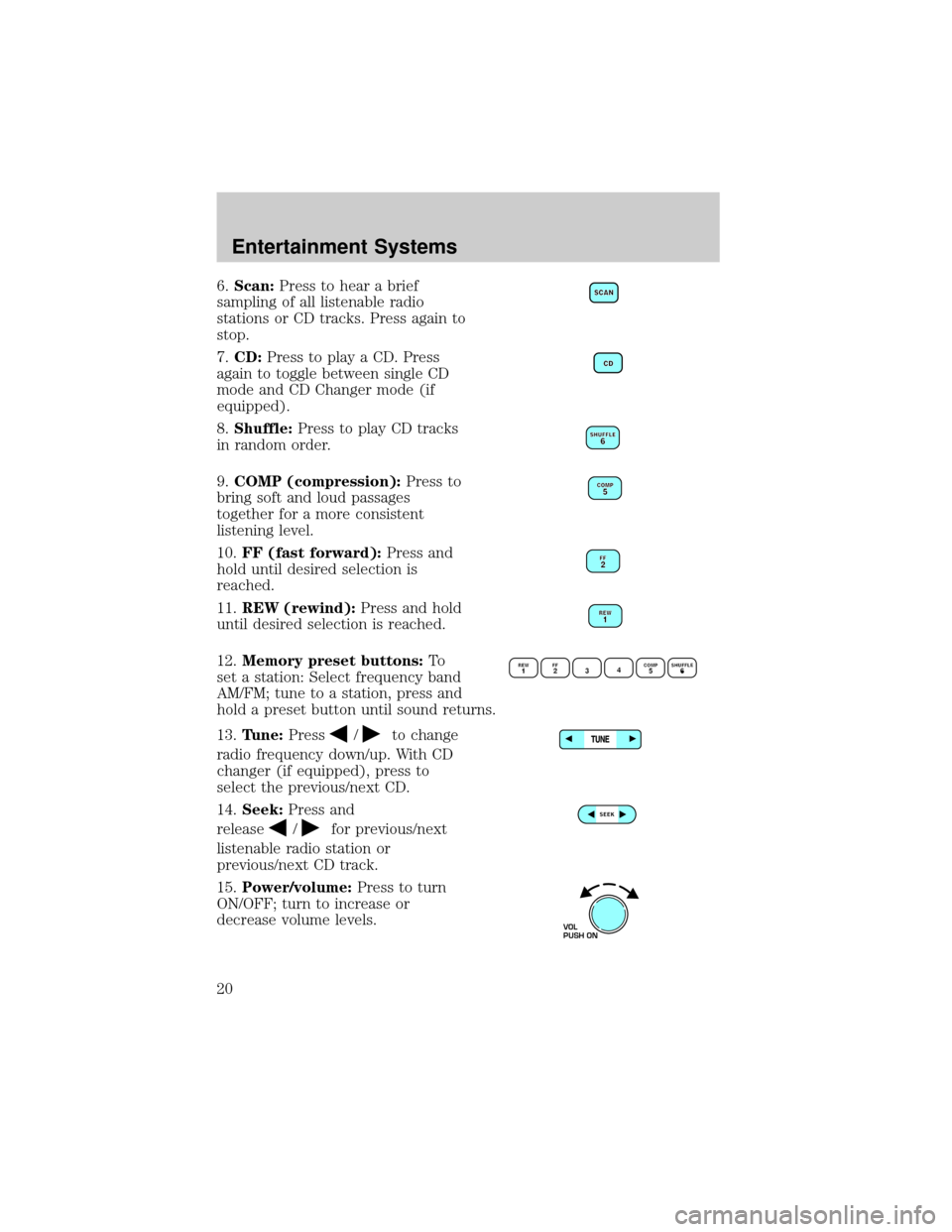
6.Scan:Press to hear a brief
sampling of all listenable radio
stations or CD tracks. Press again to
stop.
7.CD:Press to play a CD. Press
again to toggle between single CD
mode and CD Changer mode (if
equipped).
8.Shuffle:Press to play CD tracks
in random order.
9.COMP (compression):Press to
bring soft and loud passages
together for a more consistent
listening level.
10.FF (fast forward):Press and
hold until desired selection is
reached.
11.REW (rewind):Press and hold
until desired selection is reached.
12.Memory preset buttons:To
set a station: Select frequency band
AM/FM; tune to a station, press and
hold a preset button until sound returns.
13.Tune:Press
/to change
radio frequency down/up. With CD
changer (if equipped), press to
select the previous/next CD.
14.Seek:Press and
release
/for previous/next
listenable radio station or
previous/next CD track.
15.Power/volume:Press to turn
ON/OFF; turn to increase or
decrease volume levels.
VOL
PUSH ON
Entertainment Systems
20
Page 22 of 248
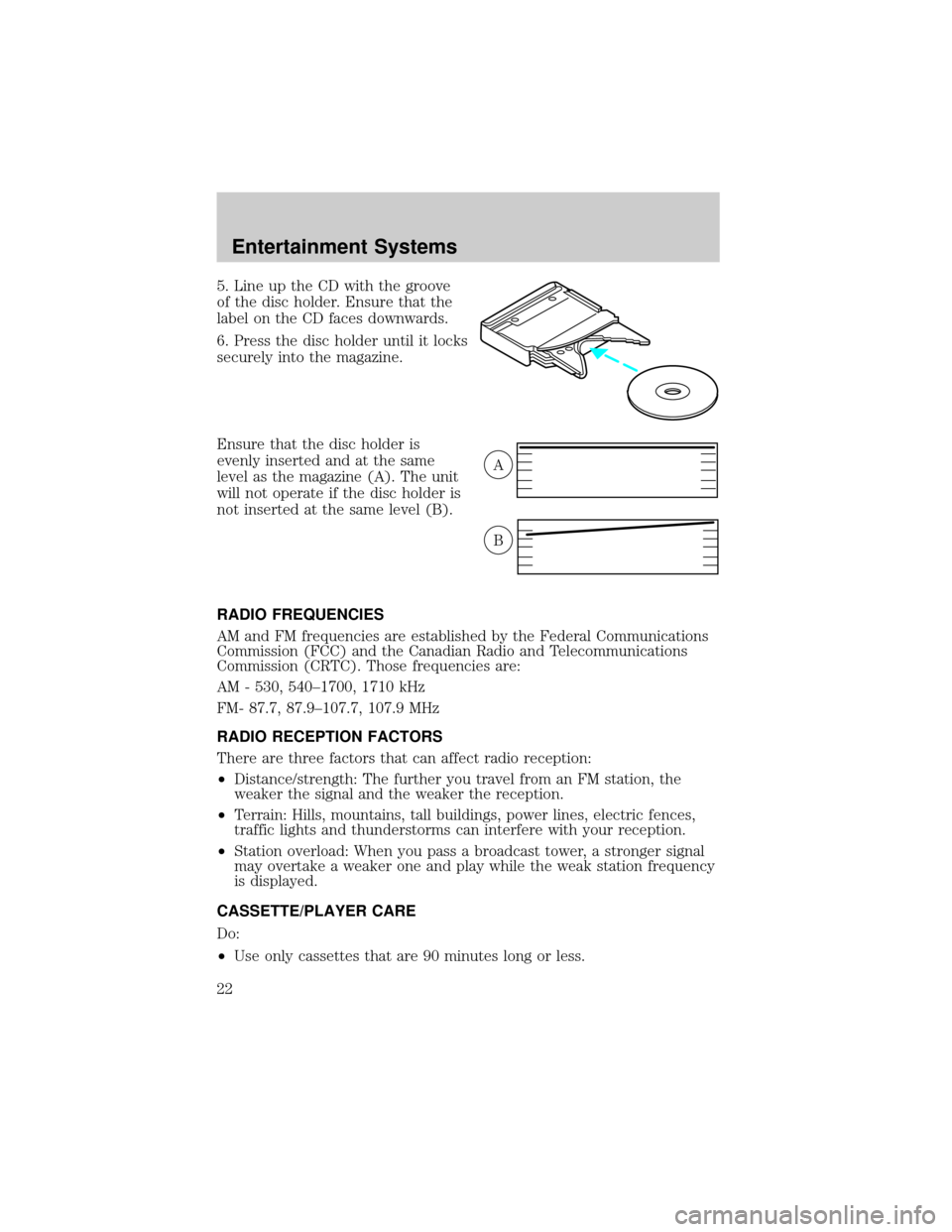
5. Line up the CD with the groove
of the disc holder. Ensure that the
label on the CD faces downwards.
6. Press the disc holder until it locks
securely into the magazine.
Ensure that the disc holder is
evenly inserted and at the same
level as the magazine (A). The unit
will not operate if the disc holder is
not inserted at the same level (B).
RADIO FREQUENCIES
AM and FM frequencies are established by the Federal Communications
Commission (FCC) and the Canadian Radio and Telecommunications
Commission (CRTC). Those frequencies are:
AM - 530, 540±1700, 1710 kHz
FM- 87.7, 87.9±107.7, 107.9 MHz
RADIO RECEPTION FACTORS
There are three factors that can affect radio reception:
²Distance/strength: The further you travel from an FM station, the
weaker the signal and the weaker the reception.
²Terrain: Hills, mountains, tall buildings, power lines, electric fences,
traffic lights and thunderstorms can interfere with your reception.
²Station overload: When you pass a broadcast tower, a stronger signal
may overtake a weaker one and play while the weak station frequency
is displayed.
CASSETTE/PLAYER CARE
Do:
²Use only cassettes that are 90 minutes long or less.
A
B
Entertainment Systems
22
Page 55 of 248
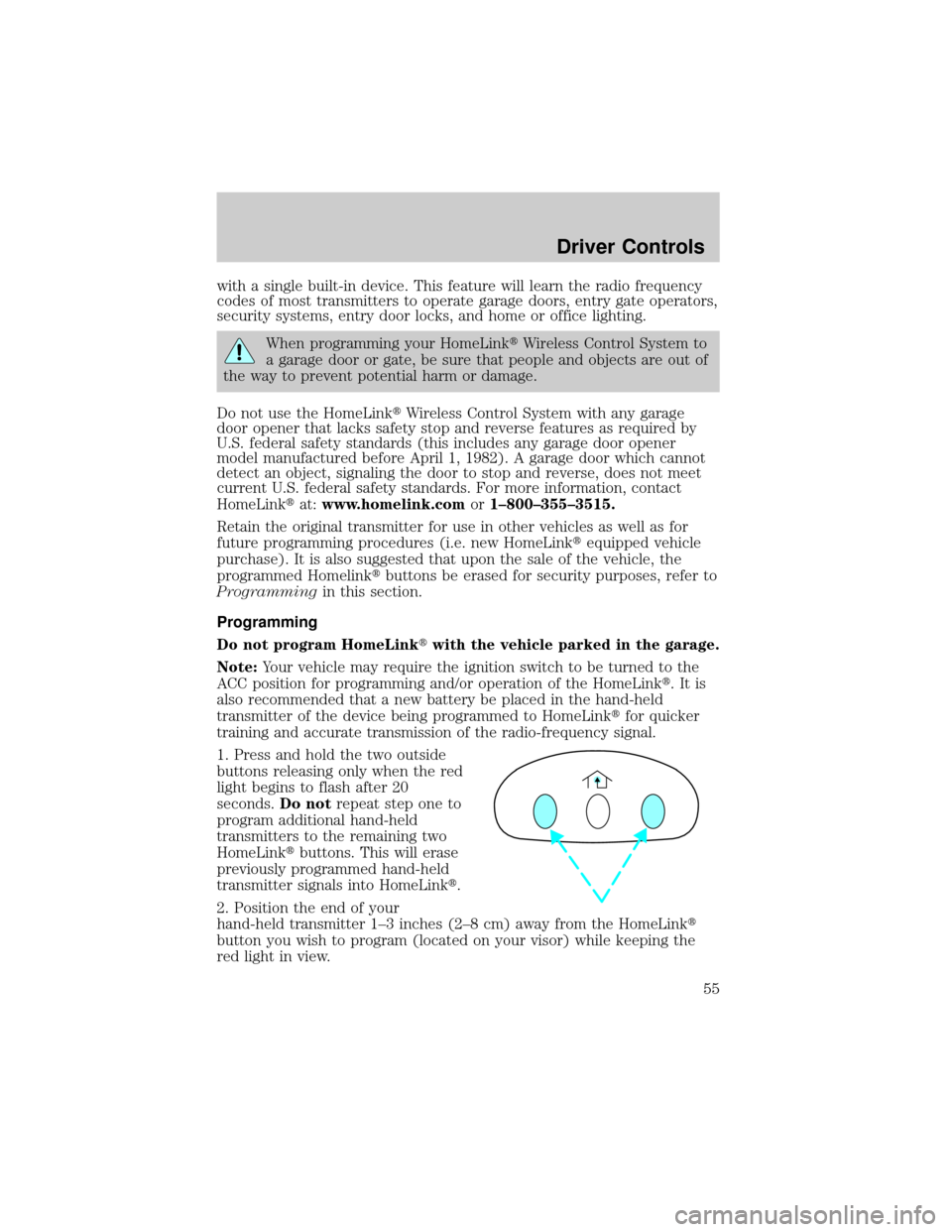
with a single built-in device. This feature will learn the radio frequency
codes of most transmitters to operate garage doors, entry gate operators,
security systems, entry door locks, and home or office lighting.
When programming your HomeLinktWireless Control System to
a garage door or gate, be sure that people and objects are out of
the way to prevent potential harm or damage.
Do not use the HomeLinktWireless Control System with any garage
door opener that lacks safety stop and reverse features as required by
U.S. federal safety standards (this includes any garage door opener
model manufactured before April 1, 1982). A garage door which cannot
detect an object, signaling the door to stop and reverse, does not meet
current U.S. federal safety standards. For more information, contact
HomeLinktat:www.homelink.comor1±800±355±3515.
Retain the original transmitter for use in other vehicles as well as for
future programming procedures (i.e. new HomeLinktequipped vehicle
purchase). It is also suggested that upon the sale of the vehicle, the
programmed Homelinktbuttons be erased for security purposes, refer to
Programmingin this section.
Programming
Do not program HomeLinktwith the vehicle parked in the garage.
Note:Your vehicle may require the ignition switch to be turned to the
ACC position for programming and/or operation of the HomeLinkt.Itis
also recommended that a new battery be placed in the hand-held
transmitter of the device being programmed to HomeLinktfor quicker
training and accurate transmission of the radio-frequency signal.
1. Press and hold the two outside
buttons releasing only when the red
light begins to flash after 20
seconds.Do notrepeat step one to
program additional hand-held
transmitters to the remaining two
HomeLinktbuttons. This will erase
previously programmed hand-held
transmitter signals into HomeLinkt.
2. Position the end of your
hand-held transmitter 1±3 inches (2±8 cm) away from the HomeLinkt
button you wish to program (located on your visor) while keeping the
red light in view.
Driver Controls
55
Page 56 of 248
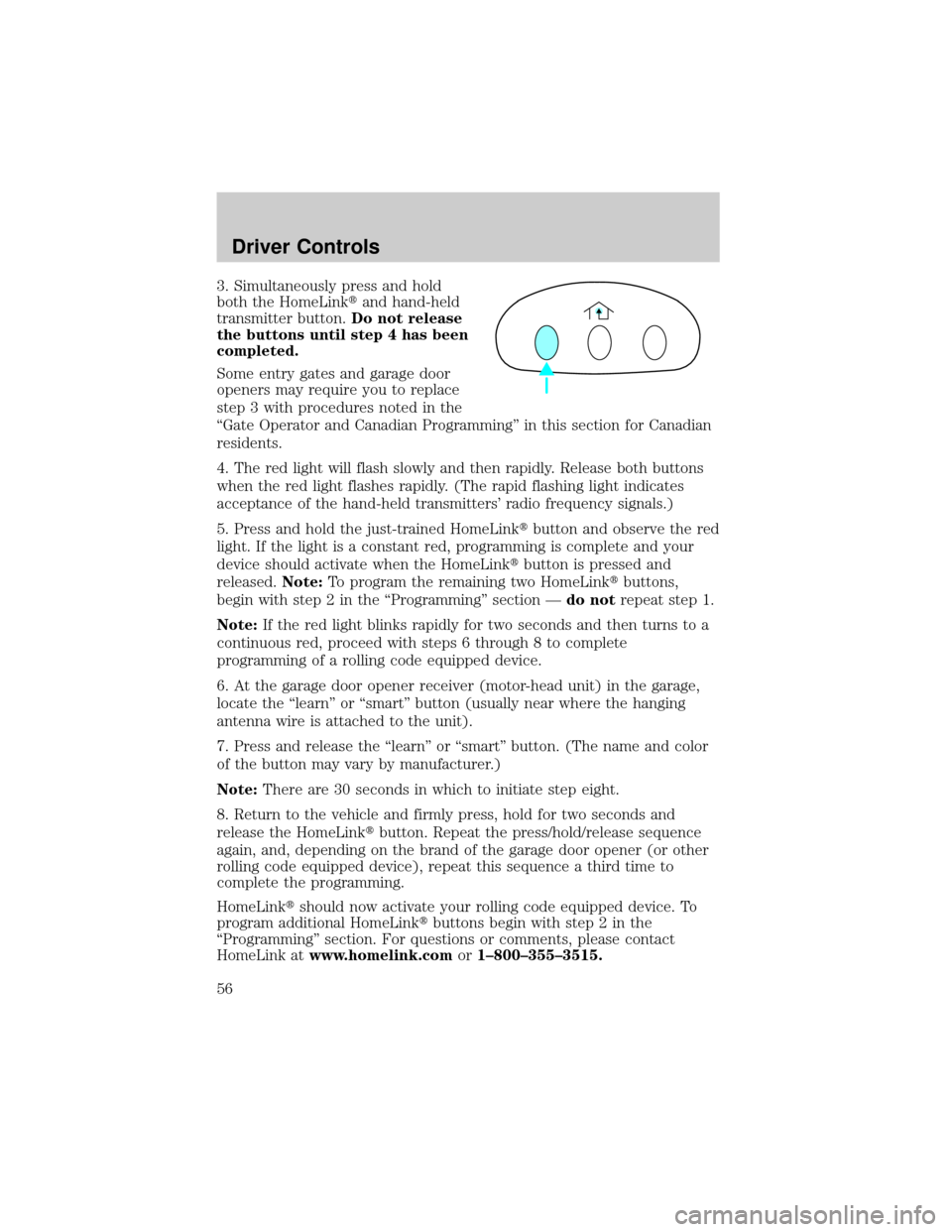
3. Simultaneously press and hold
both the HomeLinktand hand-held
transmitter button.Do not release
the buttons until step 4 has been
completed.
Some entry gates and garage door
openers may require you to replace
step 3 with procedures noted in the
ªGate Operator and Canadian Programmingº in this section for Canadian
residents.
4. The red light will flash slowly and then rapidly. Release both buttons
when the red light flashes rapidly. (The rapid flashing light indicates
acceptance of the hand-held transmitters' radio frequency signals.)
5. Press and hold the just-trained HomeLinktbutton and observe the red
light. If the light is a constant red, programming is complete and your
device should activate when the HomeLinktbutton is pressed and
released.Note:To program the remaining two HomeLinktbuttons,
begin with step 2 in the ªProgrammingº section Ðdo notrepeat step 1.
Note:If the red light blinks rapidly for two seconds and then turns to a
continuous red, proceed with steps 6 through 8 to complete
programming of a rolling code equipped device.
6. At the garage door opener receiver (motor-head unit) in the garage,
locate the ªlearnº or ªsmartº button (usually near where the hanging
antenna wire is attached to the unit).
7. Press and release the ªlearnº or ªsmartº button. (The name and color
of the button may vary by manufacturer.)
Note:There are 30 seconds in which to initiate step eight.
8. Return to the vehicle and firmly press, hold for two seconds and
release the HomeLinktbutton. Repeat the press/hold/release sequence
again, and, depending on the brand of the garage door opener (or other
rolling code equipped device), repeat this sequence a third time to
complete the programming.
HomeLinktshould now activate your rolling code equipped device. To
program additional HomeLinktbuttons begin with step 2 in the
ªProgrammingº section. For questions or comments, please contact
HomeLink atwww.homelink.comor1±800±355±3515.
Driver Controls
56
Page 57 of 248
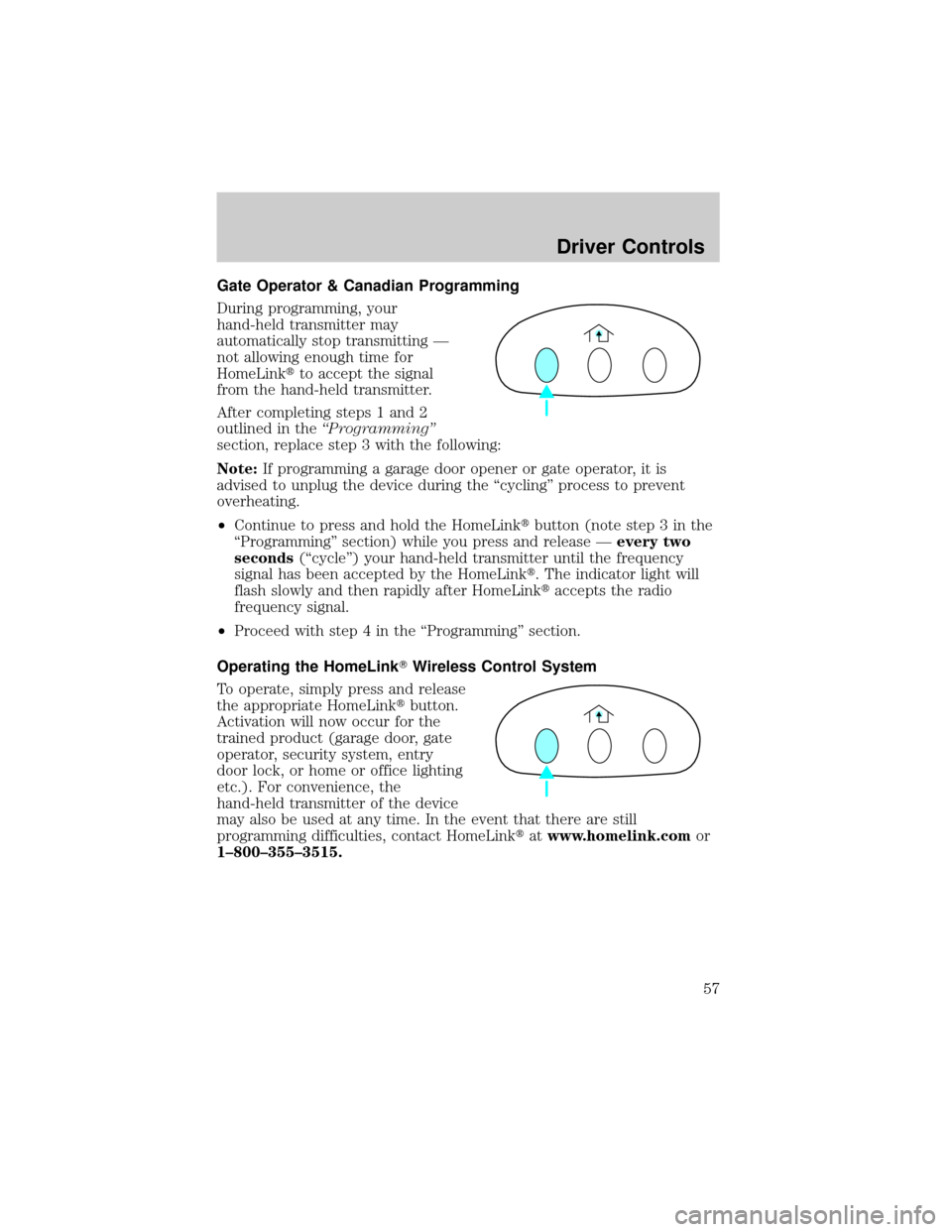
Gate Operator & Canadian Programming
During programming, your
hand-held transmitter may
automatically stop transmitting Ð
not allowing enough time for
HomeLinktto accept the signal
from the hand-held transmitter.
After completing steps 1 and 2
outlined in theªProgrammingº
section, replace step 3 with the following:
Note:If programming a garage door opener or gate operator, it is
advised to unplug the device during the ªcyclingº process to prevent
overheating.
²Continue to press and hold the HomeLinktbutton (note step 3 in the
ªProgrammingº section) while you press and release Ðevery two
seconds(ªcycleº) your hand-held transmitter until the frequency
signal has been accepted by the HomeLinkt. The indicator light will
flash slowly and then rapidly after HomeLinktaccepts the radio
frequency signal.
²Proceed with step 4 in the ªProgrammingº section.
Operating the HomeLinkTWireless Control System
To operate, simply press and release
the appropriate HomeLinktbutton.
Activation will now occur for the
trained product (garage door, gate
operator, security system, entry
door lock, or home or office lighting
etc.). For convenience, the
hand-held transmitter of the device
may also be used at any time. In the event that there are still
programming difficulties, contact HomeLinktatwww.homelink.comor
1±800±355±3515.
Driver Controls
57